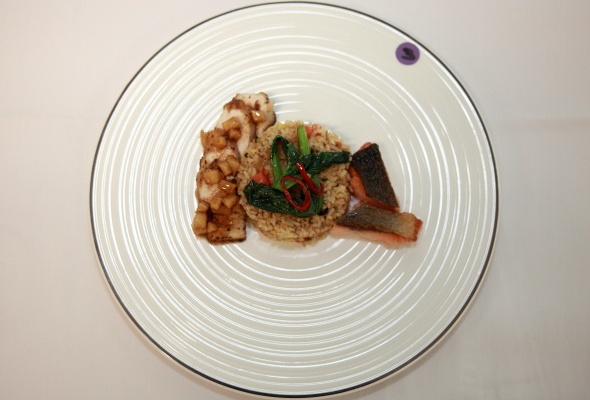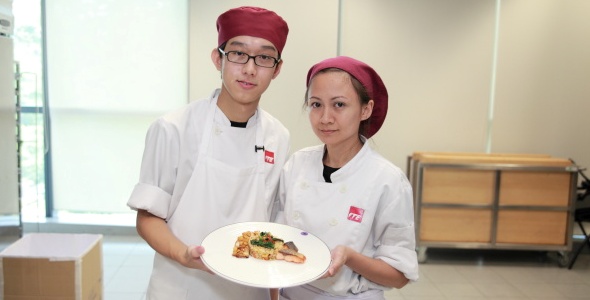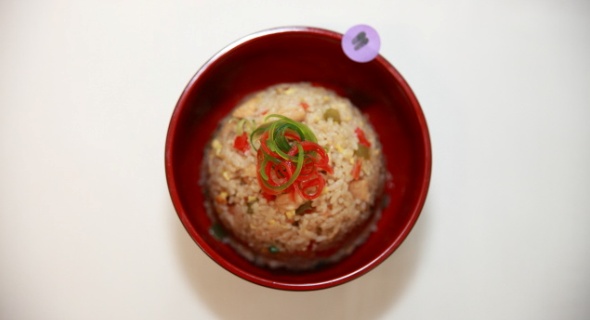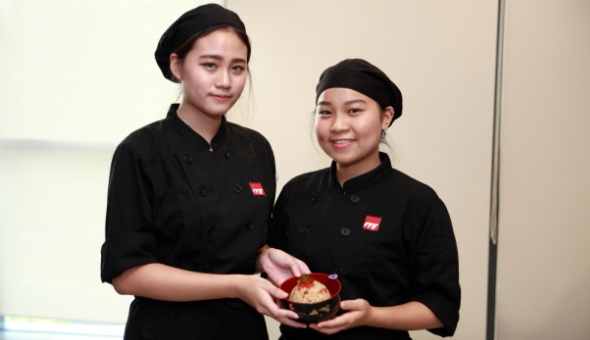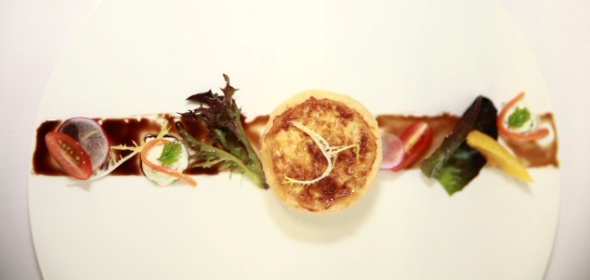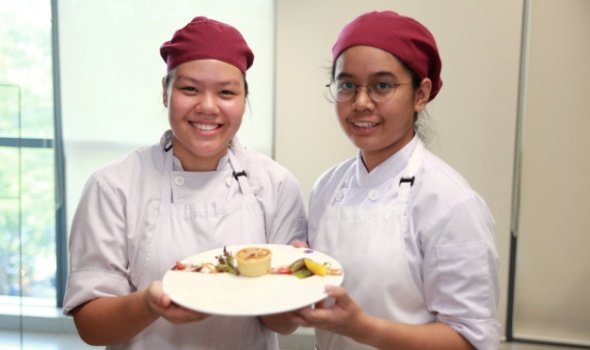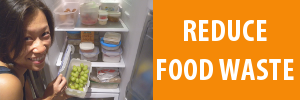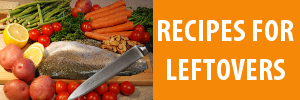Butter Rice with Chicken Breast, Fish Fillet, Vegetables and Cinnamon Apple Cubes
December 14, 2016 by Save Food Cut Waste
Filed under Carrots, Chicken, Fruits, Recipes, Rice, Tomatoes, Vegetables
If you have unconsumed cooked rice, vegetables and chicken meat, or excess carrots, tomatoes and apples at home, use this recipe to turn them into a delicious dish!
This recipe is developed by Wong Kah Jun and Sulastri, Pastry and Baking students from ITE College West.
Number of Servings: 1
Preparation and Cooking Time: 1-1.5 hours
Ingredients
- Excess Carrots – 20 g
- Spring Onion – 10 g
- Butter – 125 g
- Coriander Leaves – 2 g
- Unconsumed Chicken Breast Meat – 100 g
- Excess Tomato – 20 g
- Salmon – 100 g
- Soya Sauce – 15 ml
- Salt – 1 g
- Pepper – 1 g
- Unconsumed Vegetable – 20 g
- Sugar – 5 g
- Oil – 45 ml
- Chilli – 10 g
- Excess Apple – 1 no.
- Yellow Onion – 1 no.
- Cinnamon Powder – 2 g
- Unconsumed Cooked White Rice – 400 g
Method
- Stir fry the cubed carrots and chopped onions till lightly brown and remove from pan.
- Melt a tbsp butter in a pan, add in cooked white rice and fried till golden in colour seasoned with a little salt and pepper.
- Add in the cooked carrots, chill, onions and spring onions into the cooked rice and fry till fragrant.
- Peel and cube the apple.
- In a pan melt butter and cook the apple cubes till soft before adding cinnamon sugar. Cook till sugar caramelise. Remove and let it cool.
- Season chicken breast meat with a little salt and pepper. In a pan lightly sear the chicken, cook till golden in colour.
- Add some oil into pan and add in the salmon, skin side down and cook till the skin is crispy.
- Boil some water seasoned with salt and blanch the vegetables and soak it ice water to prevent further cooking.
- Lastly plate all the ingredients.
Food Safety
Follow these food safety tips from AVA on storing cooked food to reduce the risk of food poisoning from contaminated cooked food:
- All cooked food should be refrigerated or frozen within 2 hours after cooking.
- Store cooked food in a clean, shallow container.
- Use shallow containers and leave sufficient air space around the food to promote rapid and even cooling. Cooked food stored in large, deep containers remain warm for a longer time. Dangerous bacteria may grow in this warm spot which can lead to food poisoning if consumed.
- When freezing cooked food, make sure they are wrapped tightly.
- Keep your refrigerator uncluttered so that air can circulate and cool food properly.
- Do not refreeze frozen food that have been thawed.
- As a general rule, do not keep cooked food for more than 4 days.
Source: AVA
Disclaimer
We assume no responsibility or liability for any damages or losses you may experience as a result of following the recipes, instruction or advice on this website.
Copyright
Zero Waste SG and ITE have the rights to use the recipes and photos for our websites, publications, activities, and for other purposes.
Chicken Caps Rice
December 14, 2016 by Save Food Cut Waste
Filed under Chicken, Recipes, Rice, Tomatoes
If you have unconsumed cooked rice and chicken meat, or excess tomatoes at home, use this recipe to turn them into a delicious dish!
This recipe is developed by Lee Zhi Wei Jolyn and Chloe Chiam Ke Xuan, Asian Culinary Arts students from ITE College West.
Number of Servings: 3
Preparation and Cooking Time: 2 hours
Ingredients
- Red capsicum – 113 gm
- Green capsicum – 113 gm
- Shallot – 14 gm
- Parsley – 5 gm
- Egg – 70 gm
- Black Pepper – 12 gm
- White pepper – 8 gm
- Spring Onion – 15 gm
- Light soya sauce – 40 gm
- Dark Soya Sauce – 20 gm
- Oyster Sauce – 20 gm
- Salt – 12 gm
- Unconsumed Chicken Breast – 172 gm
- Excess Tomatoes – 70 gm
- Garlic – 6 gm
- Unconsumed White Rice – 500 gm
- Oil – 20 gm
Method
- Take out the unconsumed rice.
- Cut the cooked chicken into small pieces and season with salt and black pepper, if necessary and set it aside.
- Chop and cut the red, green capsicum, onions, tomatoes, garlic and shallots into cubes size, then set it aside.
- Slice the parsley and spring onion into small pieces and soak it in ice water.
- Heat up the wok with some oil.
- Stir fry the chicken and set it aside.
- Stir fry the garlic, red and green capsicums, onions and shallots.
- Add in the chicken and cooked rice.
- Add the light soya sauce, oyster sauce, white pepper, salt for flavour, dark soya sauce for appearance.
- Stir fry for a while using medium heat.
- Lastly, garnish it with sliced spring onion and parsley.
Food Safety
Follow these food safety tips from AVA on storing cooked food to reduce the risk of food poisoning from contaminated cooked food:
- All cooked food should be refrigerated or frozen within 2 hours after cooking.
- Store cooked food in a clean, shallow container.
- Use shallow containers and leave sufficient air space around the food to promote rapid and even cooling. Cooked food stored in large, deep containers remain warm for a longer time. Dangerous bacteria may grow in this warm spot which can lead to food poisoning if consumed.
- When freezing cooked food, make sure they are wrapped tightly.
- Keep your refrigerator uncluttered so that air can circulate and cool food properly.
- Do not refreeze frozen food that have been thawed.
- As a general rule, do not keep cooked food for more than 4 days.
Source: AVA
Disclaimer
We assume no responsibility or liability for any damages or losses you may experience as a result of following the recipes, instruction or advice on this website.
Copyright
Zero Waste SG and ITE have the rights to use the recipes and photos for our websites, publications, activities, and for other purposes.
Tomato and Chicken Quiche with Pickled Carrots
December 13, 2016 by Save Food Cut Waste
Filed under Carrots, Chicken, Recipes, Tomatoes
If you have unconsumed chicken meat, or excess tomatoes and carrots, use this recipe to turn them into a tasty quiche!
This recipe is developed by Siti Nuraini bte Adenan and Demi Yong Qian Qian, Pastry and Baking students from ITE College West.
Number of Servings: 4
Preparation and Cooking Time: 2 hours
Ingredients
Quiche Sauce
- Fresh Cream – 125 ml
- Milk – 125 ml
- Eggs – 100 g
- Salt – 3 g
- Pepper – 0.1 g
- **Seasoned unconsumed chicken and excess tomatoes
Tart Shell
- Flour – 250 g
- Butter – 125 g
- Ice Water – 45 ml
- Eggs – 20 g
Pickled Carrots
- Excess carrots (shredded) – 100 g
- Vinegar – 60 g
- Sugar – 15 g
- Water – 80 ml
Balsamic Reduction
- Balsamic Vinegar – 100 ml
- Apple Juice – 50 ml
- Sugar – 50 g
*Orange Segment, Red Radish, Cherry Tomato, Salad, Sour Cream
Method
Quiche Sauce
- Whisk all the ingredients and sift through a strainer.
Tart Shell
- Rub in the butter to the flour till sandy texture.
- Add in the ice water and eggs till a dough is formed.
- Bring to chiller to rest for 30 mins.
- Roll it out to 3mm thickness and lay into tart shells
- Add the filling, pour the quiche sauce to the top of tarts.
- Bring to bake at 180 degree Celsius for 10 minutes+/- or golden brown.
Pickled Carrots
- Stir well the vinegar, sugar and water.
- Add in the carrots and put in chiller.
Balsamic Reduction
- Bring the balsamic vinegar, apple juice and sugar to simmer under low heat until desired consistency.
Food Safety
Follow these food safety tips from AVA on storing cooked food to reduce the risk of food poisoning from contaminated cooked food:
- All cooked food should be refrigerated or frozen within 2 hours after cooking.
- Store cooked food in a clean, shallow container.
- Use shallow containers and leave sufficient air space around the food to promote rapid and even cooling. Cooked food stored in large, deep containers remain warm for a longer time. Dangerous bacteria may grow in this warm spot which can lead to food poisoning if consumed.
- When freezing cooked food, make sure they are wrapped tightly.
- Keep your refrigerator uncluttered so that air can circulate and cool food properly.
- Do not refreeze frozen food that have been thawed.
- As a general rule, do not keep cooked food for more than 4 days.
Source: AVA
Disclaimer
We assume no responsibility or liability for any damages or losses you may experience as a result of following the recipes, instruction or advice on this website.
Copyright
Zero Waste SG and ITE have the rights to use the recipes and photos for our websites, publications, activities, and for other purposes.

